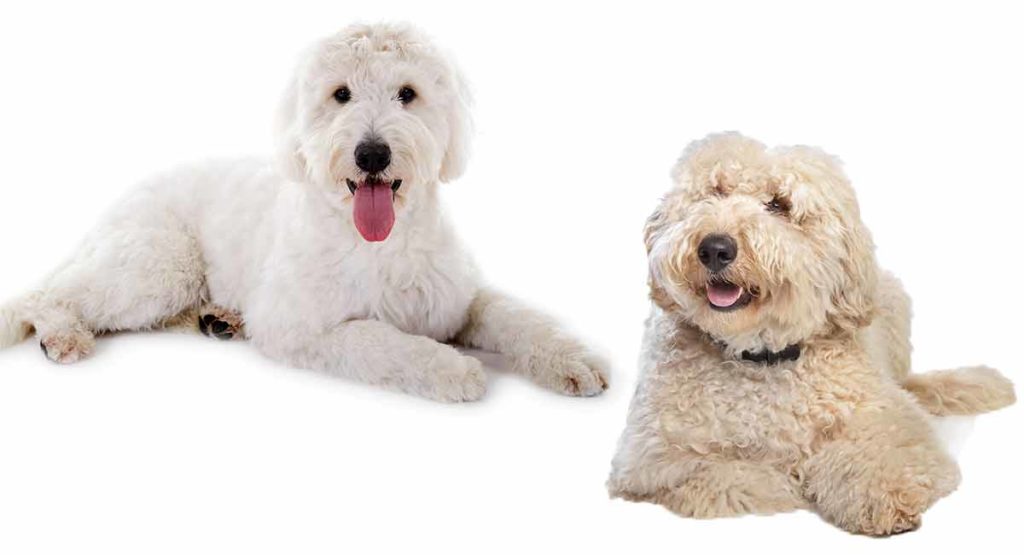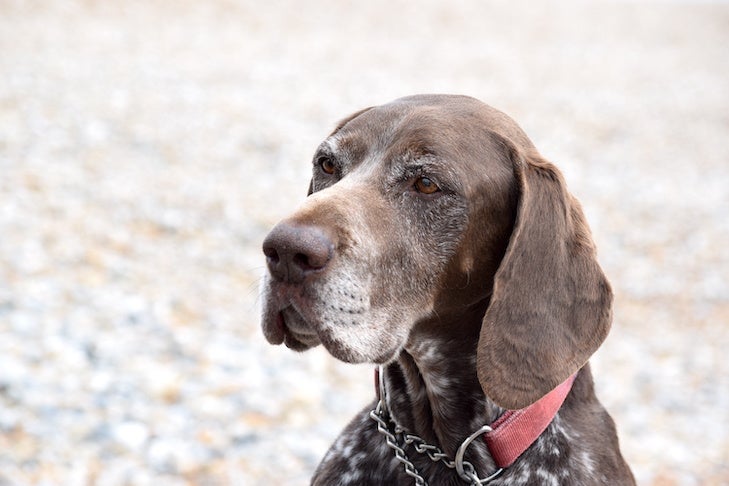Blue Heeler Husky Mix: Price, Size, Puppy and All Info
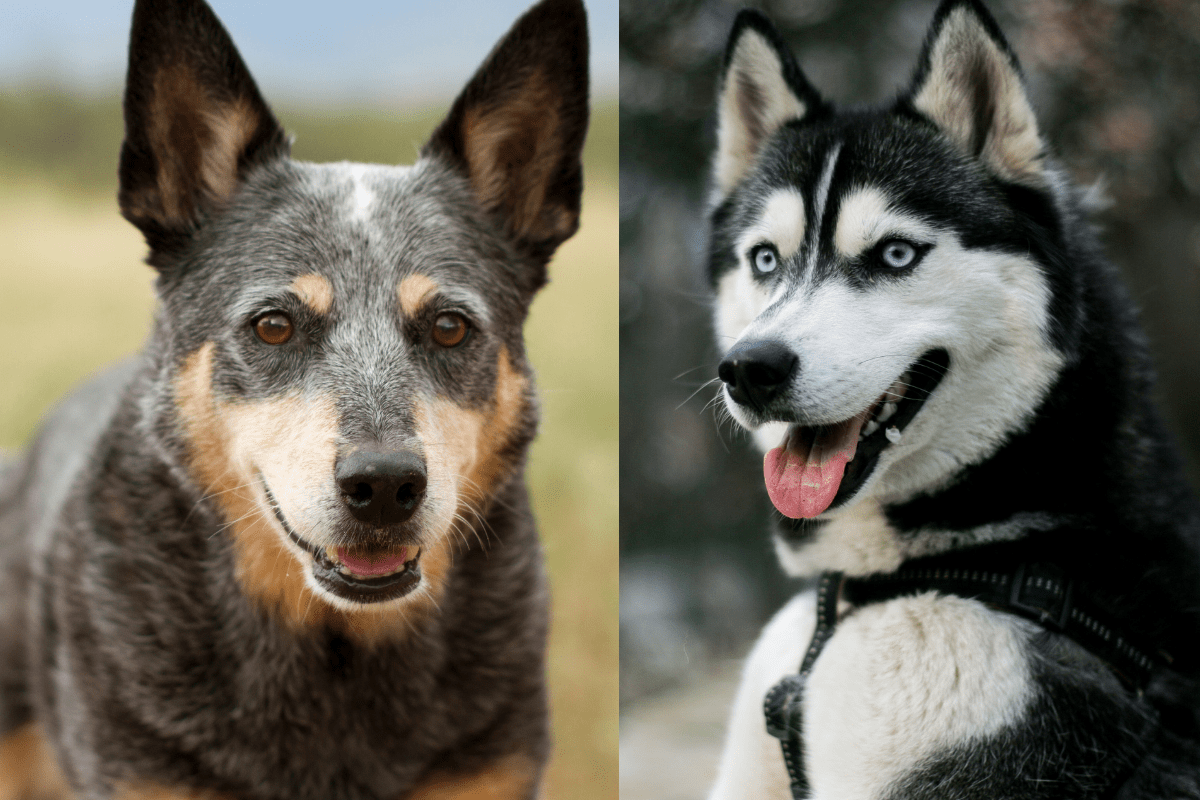
Huskies are one of the most popular breeds in the world, and not without good reason. They’re energetic, intelligent, and beautiful. But what if you’re looking for something a little more laid back? What if you want something more suited to apartment living? Why not try the blue heeler husky mix? The blue heeler husky mix (or blue Hemi husky mix) can provide all the best parts of both breeds without any downsides! Plus, they look pretty darn cute in their thick double coats.
Table of Contents
Overview: Blue heeler vs Husky
| Trait | Blue Heeler | Husky |
| Height | 18-20 inches (male)
17-19 inches (female)
|
21-23.5 inches (male)
20-22 inches (female)
|
| Weight | 35-50 pounds
|
45-60 pounds (male)
|
| Life Expectancy | 12-16 years | 12-14 years |
| Breed Group | Herding | Working |
| Behavior | alert / curious / pleasant | loyal / outgoing / mischevious |
| Barking | Low, only to alert | Low, only to alert |
| Energy | Very High | Very High |
| Adaptability | Medium | High |
| Trainability | Easy | Medium |
| Watchdog/Protective | High | Low |
| Shedding | Medium | High |
| Coat type | Smooth, Double | Smooth |
| Coat length | Short | Short |
Blue heeler husky mix
A blue healer and a husky were crossed to create the playful, friendly hybrid dog known as the blue healer husky mix. To live a long, happy life, husky mix with blue heeler require specific care and attention. They adapt well to families and are ideal for cold climates.
If you’re looking for a friendly dog breed, this combination of dog might not be the best choice because, if improperly trained, these hybrids can also be aggressive. Early socializing and appropriate training will be required. However, a Husky blue heeler mix will be devoted to and pleasant toward its owners because they always enjoy their company.
They are expected to be around you constantly because they are attention-seekers. The health problems covered on this page are also common in Blue Heeler mix with Husky. Being around the dog will be exciting because of its distinctive appearance and behavioral characteristics.
Because each puppy will differ from the others based on who and how much they have inherited their physical and behavioral features, each puppy will be unique in its own right. You can anticipate a Husky Blue Heeler Mix to resemble a blue heeler more closely if a Blue Heeler mix with Husky puppy acquires the majority of its physical and behavioral qualities from the parent blue heeler side.
However, it has been noted that this breed typically inherits both the temperament and outward appearance of its parent blue heeler and husky. Although they can be aggressive and obedient, Blue Heeler Husky Mix puppies usually receive the majority of their behavioral temperament qualities from the parent husky side.
Even though there is a high demand for Husky Mix with Blue Heeler puppies, it doesn’t make them any less endearing or desirable. Without further ado, let’s learn more about the physical attributes and personality traits of a Husky-cross Blue Heeler.
History
When we look at the history of a Blue Heeler Husky Mix, we don’t get to know much because it has recently originated the modern readers of the United States, and there is nothing much available on the information about the origin of this breed.
However, after talking with the Husky and Blue Heeler owners, we found that a Blue Heeler Husky Mix behaves much more like its parents than any other dog breed, which means that we can look at its parent’s history. Let me tell you, coma both of the parents caught a brief history to look on.
How we were to save sometimes come I am going to tell you some few facts about the history of their parents so that you can get to know few things about their parents.
Blue heeler
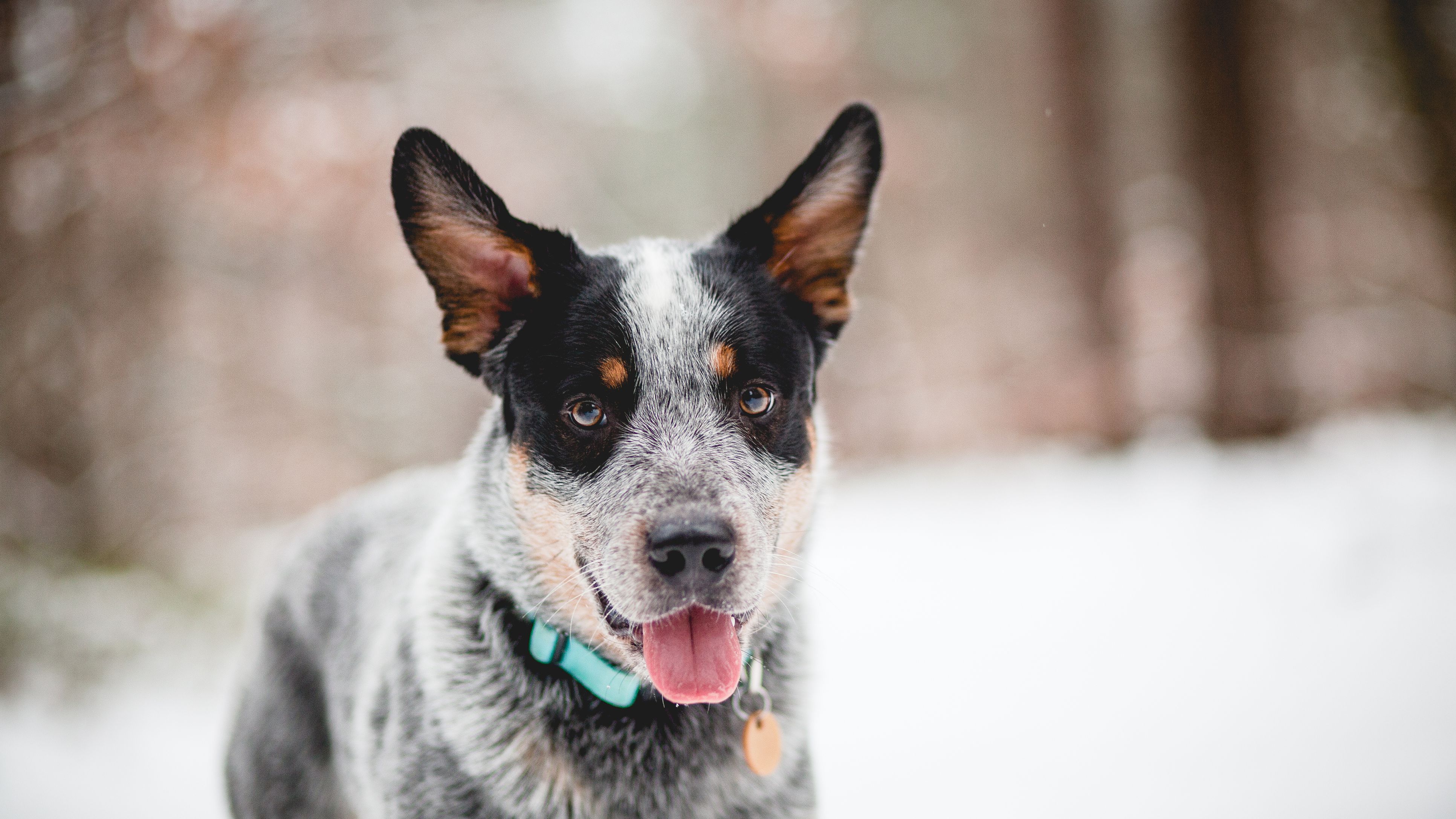
The blue heeler (Australian Cattle Dog) was bred to herd cattle by Australian settlers during the 19th century. The breed is largely credited for using its expertise to help ranchers efficiently expand the Australian beef industry.
After many breeding and cross-breeding, ranchers developed a solid and strong canine who could handle Australia’s harsh climate. Dogs brought to Australia from England were bred with the native Australian dingo to create the ancestors of the blue heeler, or Australian cattle dog, that you know today.
In May 1980 the Australian cattle dog was accepted for registration by the American Kennel Club. The breed became eligible for show in the Working Group in September of that year and was transferred to the Herding Group in 1983.
The blue heeler dog breed is also famous as the Aussie cattle dog breed or Queensland heeler.
Husky
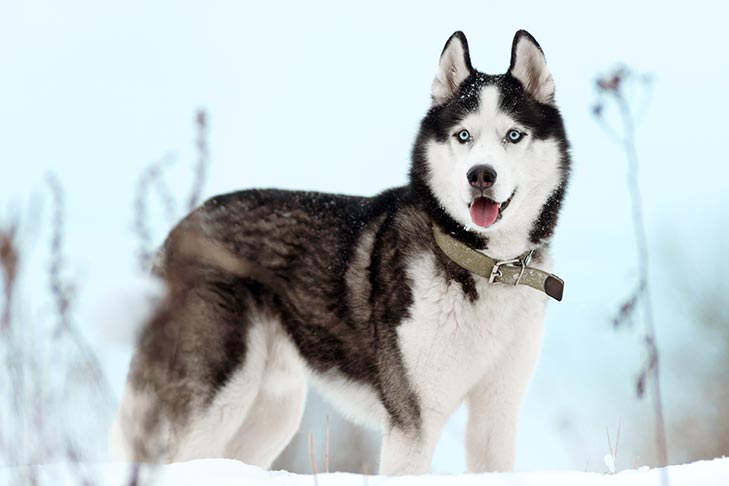
The Siberian Husky is a cross between a Samoyed and a Siberian wolf. They originated in Russia, bred to work in harsh climates. While their heritage may suggest that the Siberian Husky can only live in cold climates, this is not the case. The hair on their coat helps to protect them from cool temperatures, so as long as they have a sweater or a doggie jacket on colder days, you’ll be fine.
Appearance
Blue heeler husky mixes are categorized as medium-sized dogs. They are always moving; thus, their bodies are muscular. They have a wider body as well. They have a wide head and a medium-length snout.
They have almond-shaped eyes that can be either brown or blue.
Their eyes are so captivatingly blue that you could nearly lose yourself in them. They could potentially have heterochromatic eyes. Thus, one eye will be a certain color and the other a different color.
They receive that trait from their parent, a Husky.
They have large, triangular ears that are upright and erect. On the inside of their ears, there will be fur. If the animal has floppy ears, it is a Husky and Australian Shepherd cross.
Temperament
You’ll be shocked to learn that a Blue Heeler Husky Mix’s disposition is equally unpredictable, in addition to their outward appearance. The Blue Heeler Husky Mix is an unpredictable hybrid dog breed because of its unique attitude.
We can comprehend a store’s anticipated personality by closely examining its parents’ temperament and personality. In addition, we got some great information from talking to various Husky Blue Heeler Mix owners for you.
Blue Heeler Husky Mixes are very friendly with their owners, especially with the people they grew up with. In addition, it has been noted that a Husky Blue Heeler Mix does not adapt well to being left alone for an extended period.
Hiring a caretaker is advised if you intend to leave your Blue Heeler mix with Husky for a lengthy period. Your Blue Heeler Mix with husky is vulnerable to sadness and separation anxiety. Your dog is likely to experience depression after being left alone for a prolonged period, such as at least six hours if you have left it alone.
The breed might be victimized by depression and separation anxiety quite quickly while you are away. A Blue Heeler Husky Mix will also never tolerate being ignored by you or any of your family members, aside from those two things.
They may begin chewing on your possessions to try to get your attention if they feel neglected by you or any of your family members. A Husky Blue Heeler Mix needs specific care and attention to live a long, happy life.
If you want a good watchdog, then a Blue Heeler and Husky is the one. It will be a great watchdog. Families with children might benefit greatly from a Husky Blue Heeler mix.
You must socialize your puppy early and begin training them when they are a few months older to have a well-mannered dog in your home. Now, to be on the safe side and maintain your stone healthy or forever, it is crucial to learn about the health status of a Blue Heeler Husky Mix.
How much does the blue heeler husky mix cost?
Depending on the quality, availability, where you live, and the breeder’s reputation, a Blue Heeler Husky Mix puppy may cost anywhere from $600 to $6,000. If the puppy has health insurance, you’ll probably have to pay more than the quoted sum.
You can always find them for less money, but this can be a little hard because it might be a scam, or the sellers aren’t breeders but have a litter or two every few years.
It is crucial to find a breeder who loves and respects their dogs and is breeding them out of love and respect rather than for financial gain.
Finding a breeder for a mixed breed can be challenging, but as they grow in popularity, more reliable breeders are popping up that will sell you a puppy of the highest caliber.
Puppy mills should be avoided at all costs since the animals are mistreated and kept in appalling conditions. These locations are solely there to profit from the puppies.
Coat color
The nicest feature of their look is their coat colors. Siberian Husky and Blue Heeler hues create incredible color combinations and patterns.
White, black, blue merle, tan, red merle, black tricolor, silver, cream, brown, and gray are a few of the colors.
The double coat on these dogs is of the highest caliber. Generally speaking, their coat is short to medium in length, smooth, silky, straight, robust, and lustrous. But in addition to being lovely, their coat has a purpose.
The garment shields them from all types of weather, including rain, snow, water, and sunlight.
Health Issues
Make sure the breeder you choose has a good reputation before hiring them. The concern for their dog’s health is one indication that you have found a breeder you can rely on.
Every breeding dog will undergo DNA testing to rule out any potential health issues.
They need to perform a health check on each of their dogs. Before going to their new home, their puppies will get all the necessary veterinary examinations. But regrettably, there is always a possibility that your dog will become unwell.
Every breed, even Blue Heeler Husky hybrids, has particular health conditions that they are more likely to develop.
This does not imply that your dog will definitely experience any of these. Many of these might be avoided with routine veterinary examinations.
However, we’re trying to say that even if you do everything you can to keep your dog healthy, accidents might happen, so don’t hold it against yourself. These are the health conditions that this breed is particularly susceptible to.
1. Being deaf: As they grow older, their hearing can lower.
2. Progressive retinal atrophy: Their vision is related to this. It isn’t because they are older; rather, their retina may degrade, impairing their vision.
3. Cataracts: As a result, as your dog ages, it may begin to lose its vision. They might become blind.
4. Dysplasias of the hip and elbow: This might occur as they age or result from an injury. There are numerous therapies available, so don’t worry. However, if this occurs as they age, it can be challenging but still doable.
5. Heatstroke: They have a double coat that can protect them from heat and cold, but it is more for colder weather. Your dog may experience heatstroke if the temperature is really high and it is exercising vigorously.
6. Osteochondrosis Dissecans: This occurs when their joints don’t get enough blood.
Lifespan
Their lifespan is between 11 and 15 years. They are typically healthy dogs, and a balanced diet and amount of exercise will help them live long and fulfilling lives. Like all animals, they can develop health problems as they age. But with careful care, your furry companion can be around for many years to come.
Size, Weight, And Height
These dogs are categorized as medium-sized. They can weigh between 40 and 60 pounds and reach heights of about 18 to 24 inches. Just a little bit smaller are the females.
They are wider but not all that tall. Because of all of the mobility, they develop a muscular body. A dog’s quality of life will suffer if it becomes overweight, so watch out for that.
Shedding
They shed a lot, especially during the shedding season, because they have a double coat like both of their parents. This may be a problem if someone chooses to keep them in an apartment.
Their undercoat, or, to put it another way, that thick layer of coat that serves as the protective one, changes periodically so it can maintain the high quality, is the reason they shed.
Grooming And Caring
Every single Blue Heeler Mixed With Husky owner needs to understand that appropriate ineffective grooming will not only make a huge difference in terms of their appearance but also in terms of their health condition. Focus on their grooming demands if you want to be on the safe side.
To clarify, brushing your Blue Heeler Husky Mix’s coat is one of the most crucial parts of appropriate care. A Husky Blue Heeler Mix must be thoroughly brushed, and bathing is the second most important aspect of grooming.
Therefore, for the greatest outcome, be sure to adhere to the schedule for their wash and use the proper technique. Here, I’ll go over the proper techniques for brushing and bathing a thand the supplies you’ll need.
1. Slicker brush: You need a brush that is specifically designed to meet the needs of your Blue Heeler Husky Mix coat. Let me tell you that not every brush on the market is appropriate for the needs of your Husky Blue Heeler Mix court. Your Husky Blue Heeler Mix needs a slicker brush that will ideally assist them in removing all types of additional loose hair from the depth of their coat without causing discomfort.
This brush’s gentle bristles will make using it painless for your Blue Heeler Husky Mix. Additionally, when the brush is used on the coat of a Blue Heeler Husky Mix, they will feel cuddly. Additionally, a brush is trustworthy and strong enough to endure a long time and get the outcomes you need.
2. De-shedding tool: It’s important to spend money on a high-quality de-shedding tool because your Blue Heeler Husky Mix will need one during the shedding season. A de-shedding tool of this caliber will help you remove all loose hair in bulk with only a few strokes.
3. Shampoo: Since you can’t bathe your Blue Heeler Mixed With Husky more frequently, getting an efficient outcome with the bathing schedule is crucial. You only have a little time to claim your Blue Heeler mix with Husky during the bath fully, so you don’t want to miss it.
It is crucial to use a high-quality shampoo that will enable you to eliminate all danders and dirt from their coat efficiently. Here are a few shampoos that work well to eliminate dander and dirt of all kinds from deep within their coats. In addition, I’ll advise you only to select shampoos tailored specifically to the skin and coat of Blue Heeler Husky Mixes.
4. Air conditioning: You must have observed that most of the dog’s skin dries up following a wash, and the shedding appears excellent at that motion. This is because when you bathe a dog, the water removes their natural oil, leaving their skin dry.
Not all conditioners on the market are good for dog skin and coats. These are the conditioners that I would advise you to look at based on your needs and preferences because they are powerful enough to moisturize your Blue Heeler Husky Mix’s skin and guarantee that the quality of your coat has always been fully natural.
Diet
These dogs require two to three cups of dog food daily, distributed across two to three meals. These dogs need a nourishing dog food that will meet all of their needs because they are active.
You may always consult a veterinarian for advice if you’re unsure about the appropriate type of food for your pet.
You can give your dog probiotics to maintain the health of its kidneys and liver. The fatty acids omega-6 and omega-3 work wonders for your dog’s overall health and help keep its coats bright and healthy.
Although you can offer dog treats, try not to do so frequently. They may put on weight; as a result, worsening their health.
For instance, you may offer them a carrot so they can munch on it. They won’t put on weight from it, which benefits their teeth.
You can mix their meals as well. You can feed them home-cooked meals or foods that belong to a human being. In addition, some meals may be served as dog food. This may be a good alternative if your dog is a working dog.
Whatever you wish to provide your dog will determine everything. The most crucial factor is that the meal is nourishing and that your dog will receive all the nutrients required for healthy function. However, we suggest that you never offer kids hot food.
Training
Although this breed occasionally displays stubbornness, they are incredibly bright, so they will quickly pick up any lessons you wish to give them.
You must be persistent and demonstrate that you are the pack leader if you want to succeed. During the training process, your dog has to develop a few key behaviors, including:
- Agility
- Socialization
- Obedience
- Discipline
We’ll go through various lessons you should teach your dog, most of which should be done when they’re still puppies. Because of their limited attention span as puppies, this may sometimes be challenging.
Conclusion
Every dog is lovely in its special way. People desire to buy these cuties because of their captivating attractiveness. However, a person’s personality will either make or kill a relationship.
Although they have wonderful personalities, some individuals could find this to be a little too much.
Not everyone is eager to take care of their mental needs, so you’ll need to be ready to take them out frequently, but that’s good. For this reason, it’s crucial to do your study on the breed before buying one.
A fantastic dog that will show its owner love, devotion, loyalty, and gentleness is the Blue Heeler Husky mix. After reading this essay, we hope that you have developed a passion for this breed and that it has facilitated your decision-making a little bit naturally.
Other mix dog breeds
- Chihuahua Mix With Rottweiler
- French Bulldog Yorkie Mix
- Rottweiler Pitbull Mix
- Cur Pitbull Mix
- St Bernard Pitbull Mix
- Border Collie Dachshund Mix
- Dachshund Boxer Mix
- German Shorthaired Pointer Pitbull Mix
- Husky Greyhound Mix
- Vizsla Pitbull Mix
- Pitbull Belgian Malinois Mix
- Blue Heeler Corgi Mix
- Husky Yorkie Mix
- Shiba Pomeranian Mix
